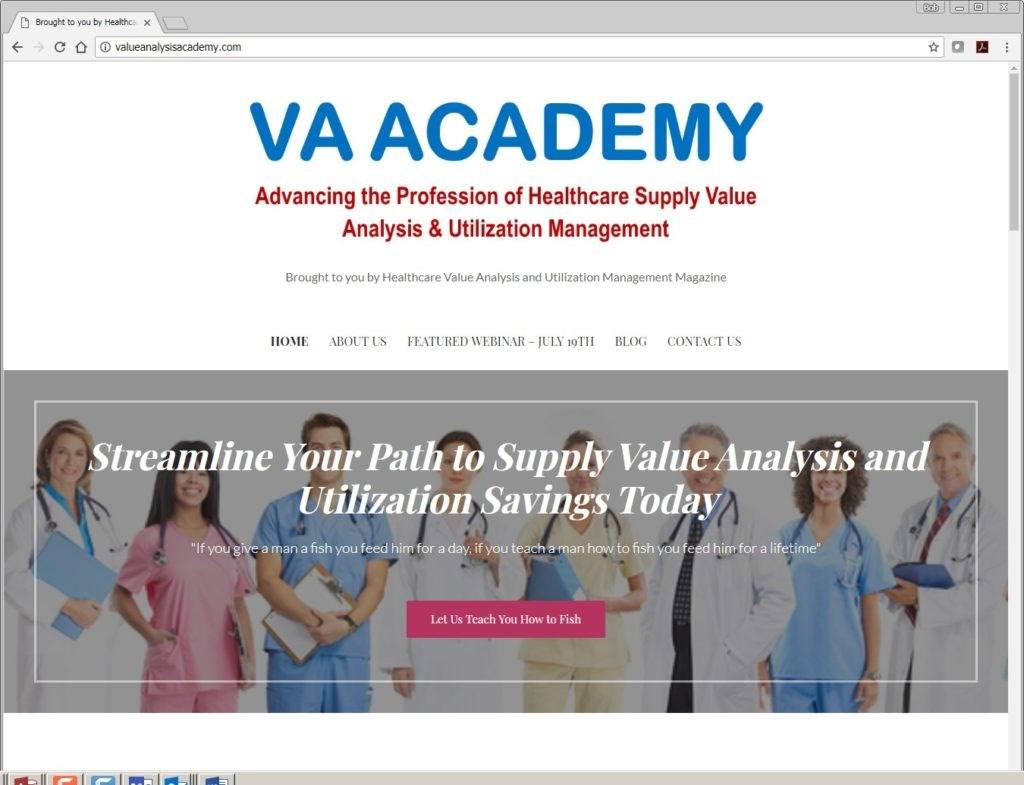
6 minute read
HEALTHCARE VALUE ANALYSIS ACADEMY
How Do You Speed Up the Value Analysis Process?
By Robert W. Yokl, Sr. VP, Operations — SVAH Solutions

The one thing that every one of us has that is equal is the amount of time that we must spend at our jobs every day. To me, one of the most overlooked savings in the supply chain world is “time savings” when it comes to managing our value analysis process at our healthcare organizations. For anyone in the supply chain or value analysis game this is an endless loop of similar but uniquely different and highly important projects that we work on every day. To make savings and quality happen we must complete/implement more VA studies which does make it a bit of a numbers game. The more studies you can work on and complete, the more savings and quality improvements you can achieve.
There are limits to how much one can do without burning out our VA Coordinators, committees/ teams, and support staff working with them. I have outlined below ways to improve that will gain back valuable time that could make a major impact on your value analysis world.
Find a Process that Always Leads You to the Right Results–One thing I learned years ago was the classic tenets of value analysis that were taught by Larry Miles, the father of value analysis. We have tweaked, perfected, and enhanced these tenets over the years into a sound process that truly makes the value analysis process steps a no-brainer in every value analysis study (supplies, services, and technologies). Remember, value analysis is the study of function and the
Healthcare Value Analysis Academy

Robert W. Yokl
search for lower cost, and equal or better-quality alternatives. Your study process should always be your checklist and guide!
Stay on Course –I cannot tell you how many times I have worked with VA Project Managers who have been pulled off course in many ways that ultimately cost them major delays in their studies. This could be a sales rep making a shiny offer, a stakeholder laying down a major unvetted must-have requirement, department heads putting the blocking moves on working with you, or just about anything else. You cannot let these things get you derailed from your original path. When that happens, make them part of your study in the process step that they need to be addressed. You don’t need to stop your study cold because a vendor just gave you a 21% discount which would double your savings opportunity. Get it in writing/spreadsheet and then make it one of your alternatives if it meets your requirements at the right time in your process. So many people stop doing VA and like a dog with a bone start chasing the big savings too early in the process.
Set Goals and Don’t Stop Until You Achieve Them –The majority of value analysis studies are started with the presumption of, “Let’s save as much as we can,” instead of laying down a solid thought-out goal of, say, 12% to 15% or $120K to $150K ($1 million annual spend). Why is this important? Well, with the “let’s save as much as we can” mindset, you may only find $50K or 5% and if you don’t have any savings goals you may just stop right there and not look for anymore. But if your goal is to save three times that (15% or $150K), then you will keep going and keep looking for the best alternative that will meet your goal. Without the goal, you will not be looking for more dollars and thus undoubtably will be leaving big bucks on the table in just about every study.
Not Utilizing Technology to Its Fullest –The almighty spreadsheet is the number one tool used in the value analysis world. It is very versatile, but it is limiting as well. Most use the templating method for working in VA, whereby we create a model for certain aspects of the VA Study and then import new data in, each and every time and manipulate it from there. This sounds great but you still must spend all the time importing, vetting, and working the data for this new study. Why not have this template worked into a database query that is automatically completed for you instead of reinventing the wheel with your templated process? Why not do this for all of your templated VA spreadsheets to save even more time?
I could go on and on with the time savings strategies for VA but the key here is to learn to take a step back from time to time and see where you can save time (not shortcut) while improving the quality of the VA Studies that you are delivering. With more time, you can bring better value to the value analysis process at all levels. Value analysis is more about engaging your customers and stakeholders, not just about crunching numbers.
Value Analysis Advisor

The Power of a Value Analysis System to Complement Your Selling Process

Robert T. Yokl, President/CEO, SVAH Solutions
If you work for almost any sales organization you have been trained to follow a certain sales process (e.g., Miller-Heiman, Sandler, Dale Carnegie, etc.) that provides you with a reliable, repeatable and auditable methodology to ensure your sales success. However, with too many competitors looking and sounding alike, you need a differentiator to make you stand out from the crowd.
To prove my point, last Monday, a dermatologist told me that she doesn’t have time to meet with sales reps who are selling stuff she can’t use in her practice. Yet, she always has time for medical device sales reps who bring a value proposition to her that makes sense. That’s how you, too, can differentiate yourself when you need to grow or just maintain your market share by becoming a value creator!
That’s where a value analysis system shines! It can complement your sales process by opening up a whole new world of savings, quality, and safety opportunities through value analysis studies. These
Value Analysis Advisor

Robert T. Yokl
same value analysis studies will provide you with those unique value propositions that will generate even more sales for you.
Close The Door to Your Competition
We know from personal experience that sales reps make a sale, then rarely look back to see if what they are selling met the requirements for the customer’s intended purpose or if their product, service or technology was implemented properly.

Consequently, our research has shown that 26% to 46% of the time, the product, service or technology that was sold was wasted, misused, misapplied, or a value mismatch for their customers. This is where you can close the door on your competition by conducting value analysis studies that will surface these problems. This will enable you to provide a better value proposition for these same customers.
Learn How to Become An Expert in Healthcare Value Analysis & Supply Utilization Management

Beginner, Intermediate and Advanced Programs Available


Healthcare Supply Chain Best Practices Podcast

Now Over 300,000 Listens!
Generate Actionable Bottom Line Savings Open Up a Whole New World of Savings Beyond Price Lead Your Organization to the Next Level of Supply Chain Performance
Provide Solutions and Tools to Save You Time, Money, and Effort
Purchase Cost Is Just the Tip of the Iceberg Reining in Your Multimillion Dollar Purchased Services Comparative Value Analysis Analytics Will Maximize Your Performance 5 Biggest Myths About Healthcare Supply Utilization Management 4 Things to Make Your Cost Management Job Easier


